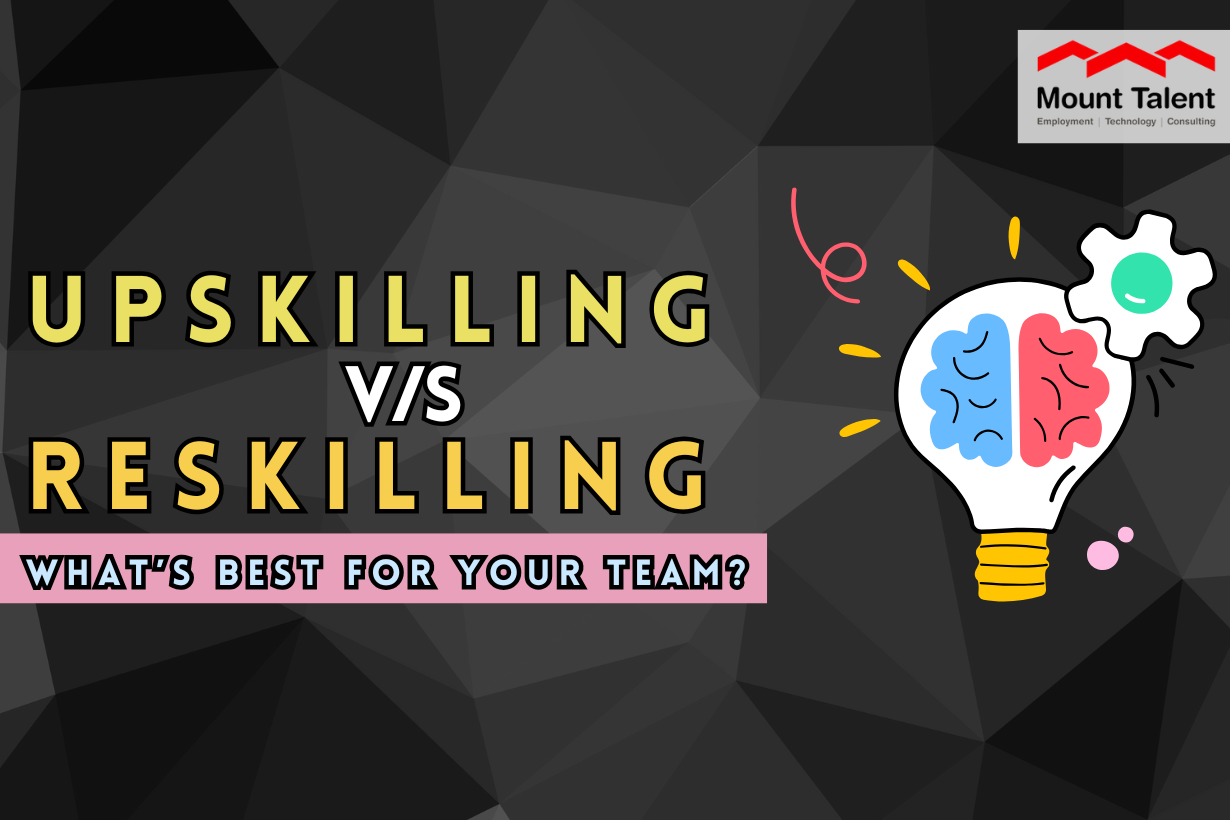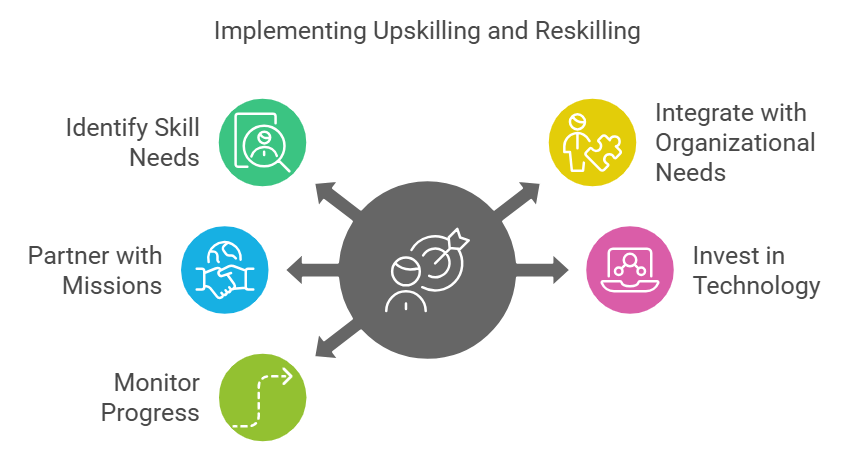
Upskilling vs. Reskilling: What’s Best for Your Team?
- by Mayank Thapa
The business environment currently is complex, dynamic, and competitive hence organizations and their teams must always stay relevant. Employers are now realizing the need to make employees productive by training them to meet up with the current market challenges. This has paved the way to the increased focus on Upskilling vs. Reskilling, both of which are vital in talent management. But what do these terms mean and how can they help your team get better? In this write-up, you will learn about the differences between upskilling vs. reskilling and the significance of the up-skill development mission toward the transformation of the workforce.
What is Upskilling?
Training can be defined as increasing an employee’s current competency to assist him/her deliver improved outcomes while remaining within the current job specification and requirements of the position. It presupposes that it is necessary to expand the knowledge of employees to constantly update it according to the further development of their specialties.
Examples of Upskilling:
- A software developer is a person engaged in writing computer software or a computer programmer in the process of learning a new programming language.
- A marketer acquiring specialists in innovative methods of analyzing big data.
- Another benefit for any Customer Service Representative is powered Chats.
- The goal for the upskilling is to develop an effective and efficient working framework for the employee so as to retain their value in the organization.
What is Reskilling?
Reskilling, in contrast, targets training the workers in completely new competencies in order to fit them for new posts at the company. It is especially important when some positions are becoming unwanted because of technology changes or market fluctuations.
Examples of Reskilling:
- An engineer mastering how to employ computerized technology in a manufacturing company.
- An HR staff moving from a general HR position to recruitment that will heavily employ statistics.
- A journalism student in the process of mastering the practice of producing digital content.
- Specifically, reskilling seeks to ensure productivity is contained within the organization by focusing the potentiality of the staff in new promising areas.
Upskilling vs. Reskilling: Key Differences
It’s crucial to know the qualities that set Upskilling vs. Reskilling to ensure that the corresponding strategies are applied to your team.
|
Aspect |
Upskilling |
Reskilling |
|
Focus |
Enhancing existing skills | Learning new skills |
|
Objective |
Improve performance in the current role |
Transition to a different role |
|
When to use |
Rapid advancements in technology |
Organizational restructuring or role redundancy |
| Example | Learning AI tools for data analysis |
Training a graphic designer for a UX role |
Both are critical starting points to an up-skill development campaign that must be waged to sustain a competitive force.
The Role of Upskilling and Reskilling in Modern Organizations
Due to new technologies such as automation, AI, and changes in market demand Upskilling vs. Reskilling has never been more important. Here’s how these approaches can transform organizations:
1. Bridging Skill Gaps
These approaches assist in closing the gap that may be experienced within an organization; whether it’s the acquisition of more complex technology skills or transitioning to new roles altogether, these strategies close the gap between upskilling and reskilling in an organization.
2. Enhancing Employee Retention
People have a tendency to remain in organizations that offer training. Measures such as the takeoff upskill program are evidence that the company cares for its employees, and will ensure their growth, thus, employee loyalty and satisfaction are improved.
3. Staying Competitive
One critical reason why skill development-performing organizations are better placed for internal transformation is because of the current changes in the industries. Upskilling and reskilling are efficient in that they keep various teams effective and ready for the next challenge.
4. Fostering Innovation
The authors explained that by providing knowledge to the workers, success becomes possible as people develop ideas and creativity on a problem-solving level.
How to Implement Upskilling and Reskilling Programs
Managing different types of courses such as Upskilling vs. Reskilling needs some important strategies. Here’s how organizations can successfully adopt these strategies:

1. Identify Skill Needs
It is suggested that organizations should perform periodic skill gap assessments in order to ascertain if more upskilling or reskilling is needed. Insights can be gained by means of surveys, assessments, and performance reviews.
2. Integrate with Organizational Needs
Make sure that organizational learning serves your strategic goals whether it’s in embracing a new technology, market, or operation streamlining.
3. Use the Up Skill Development Mission
Education has become a lifetime process where governments and organizations in different countries like India are coming up with up-skill development missions. Partner with these programs in terms of capacity as well as relevant technical assistance.
4. Invest in Technology and Tools
Software such as e-learning, VR training, or any other platform that makes learning efficient and productive should be adopted.
5. Monitor and Measure Progress
Metrics, such as productivity, satisfaction of employees engaged in upskilling or reskilling, and the number of people who embraced new skills after the interventions, should be followed by firms.
Upskilling vs. Reskilling: Which is Best for Your Team?
The decision to upskill or reskill will depend on the needs of the organization at that certain time. Here’s how to choose:
Choose Upskilling When:
- Technology plays an important role in business which is why employees have to implement new and developing technologies at their present positions.
- You wish to boost the efficiency and creativity within each and every given position that is present in an organization.
- It is about time to make sure that it remains relevant within the existing market climate.
Choose Reskilling When:
- Some positions are turning out to be obsolete because they are replaced by technology or elsewhere there is change in the market.
- There is a chance that new skills can be effective in new roles among the employees.
- You try to keep your employees on board even when there are changes in the organizational systems and structures.
- One always gets the best end of the bargain since both strategies form the foundation of a sound workforce development plan.
Success Stories: Upskilling and Reskilling in Action
1. Infosys: Equipping the employees with digital skills
With regards to its up-skill development mission, Infosys rolled out various initiatives aimed at preparing its human resources for advancement in Artificial Intelligence, Cloud Computing, and other such related fields. This takeoff upskills initiative enabled the company to stay relevant in the IT industry. This enabled the company to stay outside the realm of complacency.
2. Amazon: Reskilling for New Opportunities
In regards to reskilling, Amazon has recently launched its “Career Choice” program through which the company trains and prepares its workforce for roles that are fast growing in demand such as healthcare, information technology, and robotics. This applies in line with the company’s policy of talent retention and skill mobility.
Organizations and the Future of Upskilling and Reskilling
As industries change, the Upskilling vs. Reskilling debate will not end soon. This suggests that as machine learning, Artificial Intelligence, and robotics continue to evolve the market is likely to look for new skills. Companies with such key projects as the up-skill development mission and takeoff upskill programs will be actually in the vanguard of the new future of work.
Both approaches are very significant when it comes to the formation of a competent as well as a flexible workforce. This is the reason organizations should encourage lifelong learning as the key to creating sustainable organizations.
Conclusion
The debate between Upskilling vs. reskilling is not the disagreement of which practice is better but whether both are applicable to your team’s circumstances. These strategies explained above and enhanced organizational investment in continuous learning will go a long way in empowering employees for operation in the future. To learn more about Organisation Specific Skill Enhancement Programs and how your organization can get started visit mounttalent.com. We are more than ready to assist you in creating programs that will help your workforce be enough for the future.
FAQs
- What distinguishes upskilling and reskilling?
Answer- Upskilling improves on existing skills while reskilling provides training to the workforce for a new kind of work.
- What are the benefits of upskilling?
Answer- Through upskilling organizations are able to achieve more productivity, and innovations and also retain their employees.
- What is the nature of the skill development mission?
Answer- This upgrade skill development mission is aimed at sustaining the knowledge and skill of professionals.
- What factors make reskilling significant within the current generation employee population?
Answer- Reskilling supports organizational processes of handling the presence of robotics and other innovations that lead to role transformation, ultimately keeping valued staff in-house.
- How can businesses put in place takeoff upskill programs in their workplaces?
Answer- To implement takeoff upskill programs in businesses, organizations can use full e-learning education, specifying goals, and linking training to organizational goals.
The business environment currently is complex, dynamic, and competitive hence organizations and their teams must always stay relevant. Employers are…
